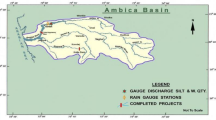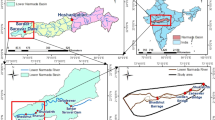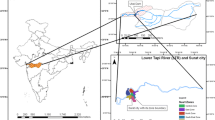Abstract
A two-dimensional (2D) hydrodynamic (HD) model is developed for densely populated Surat city, India, located on the bank of the lower Tapi River. Surat city has experienced flooding in the past during the monsoon period due to heavy releases from the Ukai Dam situated 100 km upstream of the city. In the current study, the 2D HD model is developed for the lower Tapi basin (LTB), focusing on Surat city for the past flood that occurred in August 2006. The hourly discharge from the Ukai Dam and tidal levels at the Arabian Sea was used as upstream and downstream boundary conditions, respectively. The distributed floodplain roughness coefficient based on the existing land use land cover (LULC) of the study area is considered across the flood plain. The performance of the model is evaluated against observed water levels along the channel, including maximum flood depth across the flood plain of Surat city and found satisfactory. The developed model will be useful for the local administration in predicting maximum water depth, velocity, and flood duration for various return periods floods of high magnitude and help prioritize the mitigation strategies.
Access this chapter
Tax calculation will be finalised at checkout
Purchases are for personal use only
Similar content being viewed by others
References
Quiroga VM, Popescu IA, Solomatine DP, Bociort L (2013) Cloud and cluster computing in uncertainty analysis of integrated flood models. J Hydroinf 15(1):55–70
Salimi S, Ghanbarpour MR, Solaimani K, Ahmadi MZ (2008) Floodplain mapping using hydraulic simulation model in GIS. J Appl Sci 8:660–665
Timbadiya PV, Patel PL, Porey PD (2014) One-dimensional hydrodynamic modeling of flooding and stage hydrographs in the lower Tapi River in India. Curr Sci 106(5):708–716
Jahandideh-Tehrani M, Helfer F, Zhang H, Jenkins G, Yu Y (2020) Hydrodynamic modelling of a flood-prone tidal river using the 1D model MIKE HYDRO River: calibration and sensitivity analysis. Environ Monit Assess 192:1–18
Srinivas K, Werner M, Wright N (2009) Comparing forecast skill of inundation models of differing complexity: the case of Upton upon Severn. Taylor & Francis Group, London, p 25
Timbadiya PV, Patel PL, Porey PD (2014) A 1D–2D coupled hydrodynamic model for river flood prediction in a coastal urban floodplain. J Hydrol Eng 20(2):05014017
Patel DP, Ramirez JA, Srivastava PK, Bray M, Han D (2017) Assessment of flood inundation mapping of Surat city by coupled 1D/2D hydrodynamic modeling: a case application of the new HEC-RAS 5. Nat Hazards 89(1):93–130
Mignot E, Paquier A, Haider S (2006) Modeling floods in a dense urban area using 2D shallow water equations. J Hydrol 327:186–199
Quiroga VM, Kure S, Udo K, Mano A (2016) Application of 2D numerical simulation for the analysis of the February 2014 Bolivian Amazonia flood: application of the new HEC-RAS version 5. Ribagua 3(1):25–33
Mohammad F, Ayu M, Muhammad SBK (2017) Flood hazard mapping of Palembang City by using 2D model. AIP Conf Proc 1903(1)
Gehlot LK, Jibhakate SM, Sharma PJ, Patel PL, Timbadiya PV (2021) Spatio-temporal variability of rainfall indices and their teleconnections with El Niño-Southern oscillation for Tapi Basin, India. Asia Pac J Atmos Sci 57(1):99–118
Loliyana VD, Patel PL (2020) A physics-based distributed integrated hydrological model in prediction of the water balance of a semi-arid catchment in India. Environ Model Softw 127:104677
Brunner GW (2016a) 2D modeling user’s manual. US Army Corps of Engineers, Institute for Water Resources, Hydrologic Engineering Center, pp 1–71
Brunner GW (2016b) Combined 1D and 2D modeling with HEC-RAS. US Army Corps of Engineers, Institute for Water Resources, Hydrologic Engineering Center
Acknowledgements
The authors would like to acknowledge CWC Surat; State Water Data Centre (SWDC) Gandhinagar; Ukai Civil Circle, Ukai; (SIC), Surat, SMC, Surat, and NRSC, Hyderabad for providing the required data for the present study. The authors are grateful to the Centre of Excellence (CoE) on ‘Water Resources and Flood Management’, Sardar Vallabhbhai National Institute of Technology, Surat under TEQIP-II funded by World Bank grant through the Ministry of Education (MoE), Government of India for providing a necessary infrastructural and computational facility for the work.
Author information
Authors and Affiliations
Corresponding author
Editor information
Editors and Affiliations
Rights and permissions
Copyright information
© 2024 The Author(s), under exclusive license to Springer Nature Singapore Pte Ltd.
About this paper
Cite this paper
Ravi, T., Jibhakate, S.M., Timbadiya, P.V. (2024). Flood Inundation Mapping Using 2D Hydrodynamic Model and GIS Technique for Lower Tapi Basin, India. In: Timbadiya, P.V., Patel, P.L., Singh, V.P., Manekar, V.L. (eds) Flood Forecasting and Hydraulic Structures. HYDRO 2021. Lecture Notes in Civil Engineering, vol 340. Springer, Singapore. https://doi.org/10.1007/978-981-99-1890-4_4
Download citation
DOI: https://doi.org/10.1007/978-981-99-1890-4_4
Published:
Publisher Name: Springer, Singapore
Print ISBN: 978-981-99-1889-8
Online ISBN: 978-981-99-1890-4
eBook Packages: EngineeringEngineering (R0)




